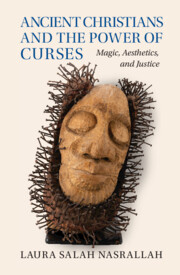Book contents
- Ancient Christians and the Power of Curses
- Ancient Christians and the Power of Curses
- Copyright page
- Dedication
- Contents
- Figures
- Plates
- Preface
- Acknowledgments
- Abbreviations
- Note on the Cover
- Introduction: Curses, Religion, Aesthetics
- 1 Making Justice
- 2 Substance and Story
- Interlude
- 3 Tongues, Breath, Stutter
- 4 Incantation
- Conclusions
- Ancient Sources
- Bibliography
- Index of Ancient Sources
- Index
- Plate Section (PDF Only)
3 - Tongues, Breath, Stutter
1 Corinthians and a Corinthian Curse
Published online by Cambridge University Press: 02 June 2024
- Ancient Christians and the Power of Curses
- Ancient Christians and the Power of Curses
- Copyright page
- Dedication
- Contents
- Figures
- Plates
- Preface
- Acknowledgments
- Abbreviations
- Note on the Cover
- Introduction: Curses, Religion, Aesthetics
- 1 Making Justice
- 2 Substance and Story
- Interlude
- 3 Tongues, Breath, Stutter
- 4 Incantation
- Conclusions
- Ancient Sources
- Bibliography
- Index of Ancient Sources
- Index
- Plate Section (PDF Only)
Summary
“If I speak in the tongues of mortals and angels, but do not have love, I am resonating bronze or a clanging cymbal” (1 Cor. 13.1).2 These words were written in a letter by Paul and Sosthenes and read aloud to Christ-followers in Roman Corinth in mid-first century. The first recipients of the letter called themselves an ekklēsia or assembly, a political term indicating civic engagement and debate.3 They included those of low status, the enslaved, and women. We already met the garland weaver Karpimē Babbia, whom we met in the Introduction. To their north, the blue waters of the Corinthian Gulf lapped at Lechaion Harbor; to their south, they were shadowed by a high, rocky Acrocorinth, which sheltered defixiones or curse tablets. Eighteen curses have been found at the Acrocorinth’s Sanctuary of Demeter and Kore, and more than thirty within the larger region of the Corinthia.
- Type
- Chapter
- Information
- Ancient Christians and the Power of CursesMagic, Aesthetics, and Justice, pp. 147 - 202Publisher: Cambridge University PressPrint publication year: 2024

